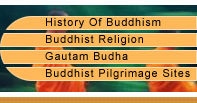Buddhism is one of the oldest religions of the world. Buddhism is practiced by a large number of people in many parts of the world, particularly the South East Asian countries. As Buddhism made progress and spread to different parts of the world, new thoughts and improvisations came to be attached with the existing beliefs and practices. This led to the development and evolution of different schools of Buddhism or Buddhist sects. Surviving schools of Buddhism can be roughly grouped as Theravada, Mahayana and Vajrayana. Most of the Buddhist schools and sects encourage followers to adhere to certain practices and philosophies. Some of these philosophies and practices are common whereas some unique to the particular school or sect.
Mahayana Buddhism
Mahayana Buddhism is considered to be one of the two major schools of Buddhism. Also known as the Greater Vehicle, it first surfaced in the first century CE. Literally, Mahayana means Greater Ox-Cart and it serves as a more moderate and comprehensible interpretation of Buddhism. Not only the monks and ascetics, but also the common people may follow the path of Mahayana. Today, the sect is predominant in North Asia and the Far East, including China, Japan, Korea, Tibet and Mongolia.
Tantric Buddhism (Vajrayana Buddhism)
Tantric Buddhism is quite different form a number of other Buddhist forms. Also known as Vajrayana, it is considered as one of the three major 'vehicles' (Yanas) of Buddhism, along with Theravada and Mahayana. Vajrayana Buddhism is based, to a certain extent, on the tantras, tantric techniques written in Indian scriptures. It prescribes the technique of 'use the result as the Path'. It means that a person should try to identify with the enlightened body, speech and mind of a Buddha.
Theravada Buddhism
Theravada literally means 'The Way of the Elders'. This term embodies the entire sect in itself, as Theravada Buddhism is based on the original beliefs and practices of the Buddha and the early monastic Elders. Also known as Hinayana Buddhism, it is mainly predominant in southern Asia, especially in Sri Lanka, Myanmar (Burma), Thailand, Cambodia and Laos.
Tibetan Buddhism
Tibetan Buddhism is the body of the Buddhist doctrine and institutions found in Tibet, the Himalayan region, Mongolia, Buryatia, Tuva, Kalmykia (Russia) and northeastern China. It is also known by the name of Vajrayana. In this article, we will provide you with a brief introduction to Tibetan Buddhism.
Western Buddhism
The western counties saw the emergence of Buddhism somewhere around the 19th and the 20th century. The scholars as well as the colonists of that time are credited with the origin of Buddhism in the West. One of the major incidents in the journey of Buddhism in the West was the establishment of the Pali Text Society. This nineteenth century society was the result of the efforts of T.W. Rhys Davies. Another name worth mentioning in this context is that of Edward Arnold.
Zen Buddhism
The Mahayana sutras that were written in India and China form the basis of Zen Buddhism. Of these, the most prominent ones are the Lankavatara Sutra, the Diamond Sutra, the Samantamukha Parivarta, the Heart Sutra, a chapter of the Lotus Sutra and the Platform Sutra of Huineng. The fundamental elements of Buddhist philosophy consist of the basics of Zen Buddhism also.
Many schools of Buddhism have developed since the inception of Buddhism. Know more about the main schools of
Buddhism/Buddhist.
Buddhist Temples: Schools of Buddhism





